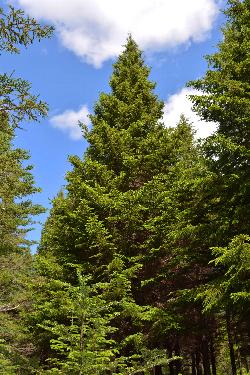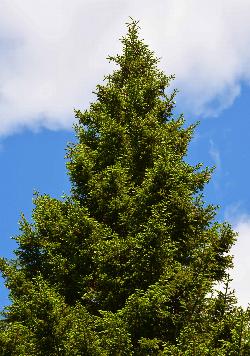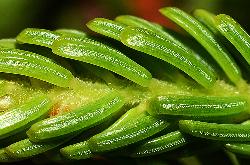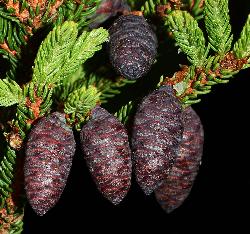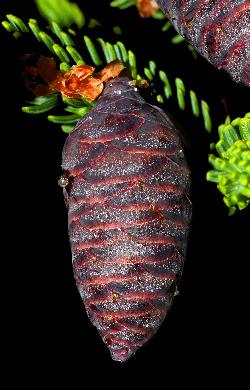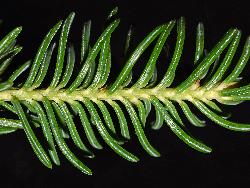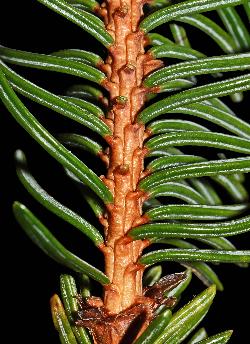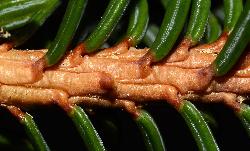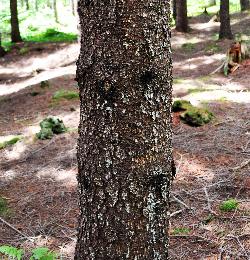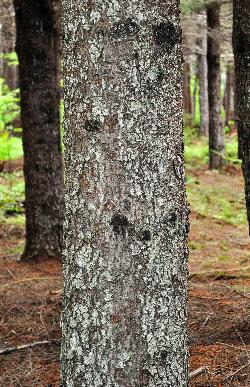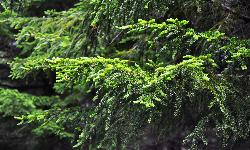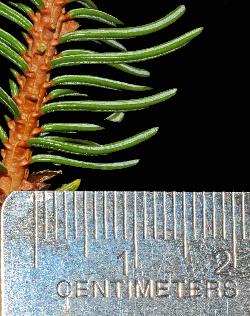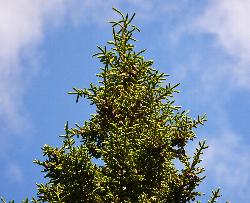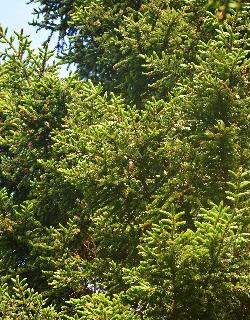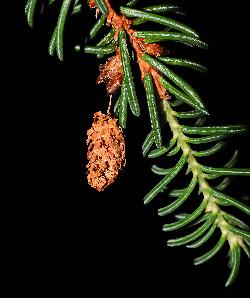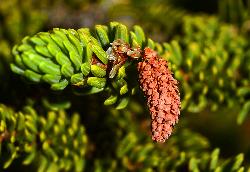Fr: épinette rouge, épicéa rouge, épinette jaune
Pinaceae - Pine Family
Note: Numbers provided in square brackets in the text refer to the image presented above; image numbers are displayed to the lower left of each image.
General: A medium-sized evergreen tree [1–3], to 25 m tall, up to 60 cm d.b.h., and with a conical profile; red spruce is a long-lived species, reaching 300–400 years-old (Farrar 1995). Red spruce is very shallow-rooted, and thus very susceptible to windthrow, making recommendations of partial harvesting advisable; it is also very shade-tolerant, possibly more shade tolerant than balsam fir (Blum 1990). Commercially, red spruce is used for pulpwood, lumber, and for making musical instruments (Blum 1990). Due to its limited distribution in Newfoundland, its role as provider of cover and food for small mammals and birds is minimal.
Key Features:
- Red spruce twigs have dense to scattered white or pale non-glandular hair, most noticeable in the depression between decurrent needle bases [4–5].
- The 4-angled needles have persistent peg-like bases (sterigmata) [6–7], which in red spruce are noticeably darker than those of black spruce.
- Seed cones are narrowly ovoid and similar in shape to those of black spruce, but red spruce cones are larger, 3–5 cm long, and more pointed (acute) at the base [8–9]. Red spruce cones are dehiscent after seeds are shed in autumn.
Stems/twigs: Young twigs are pale green, while woody twigs are light brown and shiny. Emerging shoots bear short white non-glandular hairs [4], visible only with a hand lens; most stems are glabrate, losing their hairs as the twigs develop [10–11]. Close examination of most stems shows scattered hairs remaining in the depressions between decurrent needle bases [12], while occasional stems with short internodes were observed with a fairly dense scattering of hairs [13]; on these stems, the shiny surface of the stems is still clearly visible. The pointed (acute) buds are reddish-brown, 5–8 mm long, with narrowly ovate to lanceolate bud scales [14]. The bark is greyish-brown to reddish-brown [15–16].
Needles: Evergreen, simple, stalked, and spirally arranged. Needles are slender, stiff, slightly curved, 0.8–2.5 cm long, yellowish-green to dark green, and glabrous [17–18]. The 4-angled needles have a distinct white line along each side, formed by parallel rows of small white dot-like stomates [10-11]. The apex of the needle is blunt to sharply pointed (acuminate) and curved slightly upwards. Like other spruce species, the needles of red spruce narrow abruptly at the base to persistent woody peg-like attachments (sterigmata) and are decurrent along the stem [6–7]. In red spruce, the sterigmata are noticeably darker in comparison to those of black spruce.
Reproductive structures/cones: Unisexual, plants monoecious, with separate male and female cones borne on the same tree [19–20]. Both male (pollen) and female (seed) cones are borne on year-old branches; pollination is by wind (anemophily). Male cones [21–23] are small, 1–1.4 cm long, oblong, reddish-brown to yellow at maturity, and falling after pollen is shed. Seed cones [8–19, 24] are narrowly ovoid, 3–5 cm long, acute at the tip, and turn from purplish-brown to green to brown at maturity. Cone scales are obovate with rounded entire outer margins. Cones are dehiscent within a year after seeds are shed. Seeds are about 2 mm long with an oblanceolate wing 3–5 mm long; seed dispersal is primarily by wind (anemochory). While black spruce often reproduces vegetatively through layering, red spruce rarely layers.
Ecology and Habitat: Naturally occurring red spruce is an extremely rare tree on the Island of Newfoundland, with only one known native site on the south coast. It is absent from Labrador. Where planted in research plantations in western and central Newfoundland, red spruce appears to grow as well as other spruce species, suggesting its rare occurrence on the Island is due to factors other than climate or soil conditions.
Edaphic Grid: See image [25]: the Edaphic Grid for Picea rubens.
Forest Types: Due to its scarcity in Newfoundland, red spruce has never been recorded in forest classification plots.
Succession: Successional patterns of red spruce in Newfoundland and Labrador are also not known due to its scarcity. However, within its natural range, it produces mature seeds from September to October, with germination and establishment occurring most frequently in the spring and rarely in the fall. Germination is more successful on shallow or scarified humus, rather than on deep organic layers. It is very shade-tolerant and can survive for up to 400 years. It can form pure stands or occurs in mixed stands with other conifer species. It is not fire adapted, and fires and clearcutting have considerably reduced its historic range throughout eastern North America (Blum 1990).
Distribution: Red spruce is known from only one location in south-central Newfoundland, north of Bay D’Espoir. In Canada, the range of red spruce extends mainly from the Maritime Provinces to southern Québec and eastern Ontario. Discontinuous stands may also be found in Haliburton Township, in Algonquin Provincial Park, and near Sturgeon Falls in Nipissing Township, and in southwestern Parry Sound District in Ontario, Canada (Blum 1990). In the United States, red spruce extends west from Maine to Pennsylvania, and south along the Appalachian Mountains to Virginia, North Carolina, and Tennessee.
Similar Species: Red spruce is most similar to black spruce (Picea mariana (Mill.) Britton, Sterns & Poggenb.), which can be differentiated by it densely brown-pubescent twigs, narrow profile with a club-shaped crown, and shorter semi-serotinous seed cones, 2–3 cm long, which are retained in the crown for several years. White spruce (Picea glauca (Moench) Voss) has a similar profile to red spruce, but can be distinguished by its glabrous, often glaucous twigs, and its longer cylindrical cones, 3–6+ cm long.


